Manage Cumulus Linux and NetQ Images
You can manage both Cumulus Linux and Cumulus NetQ images with LCM. They are managed in a similar manner.
Cumulus Linux binary images can be uploaded to a local LCM repository for upgrade of your switches. Cumulus NetQ debian packages can be uploaded to the local LCM repository for installation or upgrade. You can upload images from an external drive.
The Linux and NetQ images are available in several variants based on the software version (x.y.z), the CPU architecture (ARM, x86), platform (based on ASIC vendor, Broadcom or Mellanox), SHA Checksum, and so forth. When LCM discovers Cumulus Linux switches running NetQ 2.x or later in your network, it extracts the meta data needed to select the appropriate image for a given switch. Similarly, LCM discovers and extracts the meta data from NetQ images.
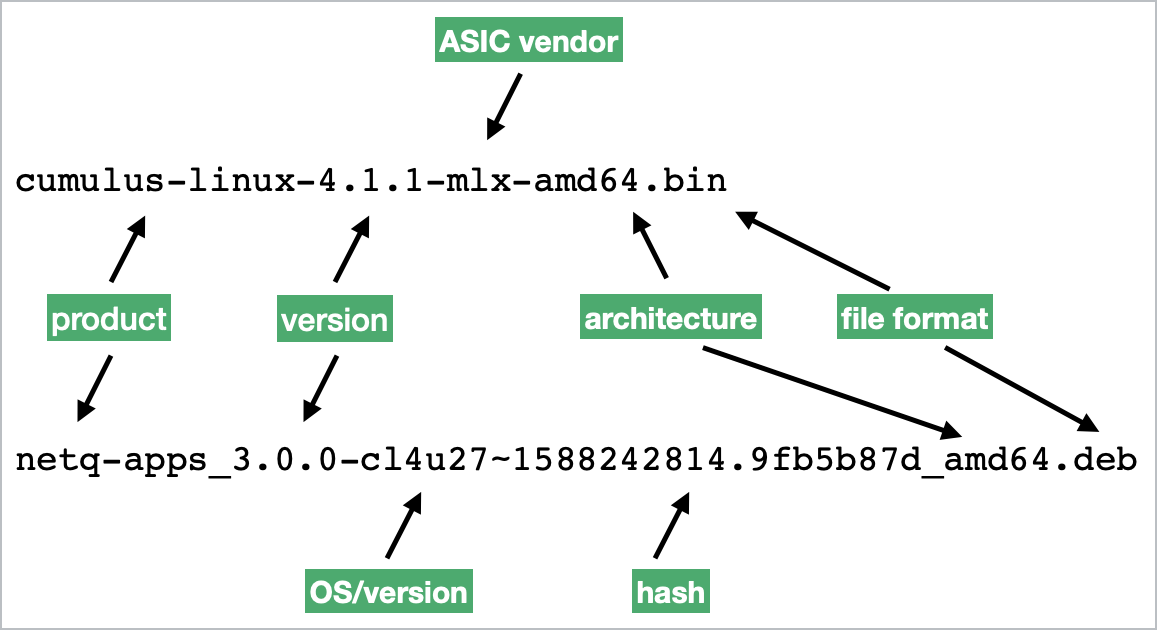
The Cumulus Linux Images and NetQ Images cards in the NetQ UI provide a summary of image status in LCM. They show the total number of images in the repository, a count of missing images, and the starting points for adding and managing your images.
The netq lcm show images command also displays a summary of the images uploaded to the LCM repo on the NetQ appliance or VM.
Default Cumulus Linux or Cumulus NetQ Version Assignment
In the NetQ UI, you can assign a specific Cumulus Linux or Cumulus NetQ version as the default version to use during installation or upgrade of switches. It is recommended that you choose the newest version that you intend to install or upgrade on all, or the majority, of your switches. The default selection can be overridden during individual installation and upgrade job creation if an alternate version is needed for a given set of switches.
Missing Images
You should upload images for each variant of Cumulus Linux and Cumulus NetQ currently installed on the switches in your inventory if you want to support rolling back to a known good version should an installation or upgrade fail. The NetQ UI prompts you to upload any missing images to the repository.
For example, if you have both Cumulus Linux 3.7.3 and 3.7.11 versions, some running on ARM and some on x86 architectures, then LCM verifies the presence of each of these images. If only the 3.7.3 x86, 3.7.3 ARM, and 3.7.11 x86 images are in the repository, the NetQ UI would list the 3.7.11 ARM image as missing. For Cumulus NetQ, you need both the netq-apps and netq-agent packages for each release variant.
If you have specified a default Cumulus Linux and/or Cumulus NetQ version, the NetQ UI also verifies that the necessary versions of the default image are available based on the known switch inventory, and if not, lists those that are missing.
While it is not required that you upload images that NetQ determines to be missing, not doing so may cause failures when you attempt to upgrade your switches.
Upload Images
For fresh installations of NetQ 3.2, no images have yet been uploaded to the LCM repository. If you are upgrading from NetQ 3.0.0 or 3.1.0, the Cumulus Linux images you have previously added are still present.
In preparation for Cumulus Linux upgrades, the recommended image upload flow is:
-
In a fresh NetQ install, add images that match your current inventory: Upload Missing Images
-
Add images you want to use for upgrade: Upload Upgrade Images
-
In NetQ UI, optionally specify a default version for upgrades: Specify a Default Upgrade Image
In preparation for Cumulus NetQ installation or upgrade, the recommended image upload flow is:
-
Add images you want to use for installation or upgrade: Upload Upgrade Images
-
Add any missing images: Upload Missing Images
-
In NetQ UI, optionally specify a default version for installation or upgrade | Specify a Default Upgrade Image
Upload Missing Images
Use the following instructions to upload missing Cumulus Linux and NetQ images:
For Cumulus Linux images:
- On the Cumulus Linux Images card, click the View # missing CL images link to see what images you need. This opens the list of missing images.
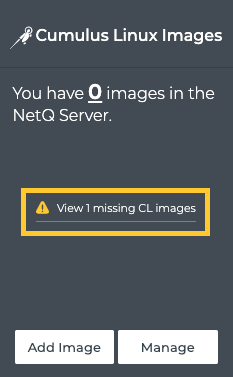
If you have already specified a default image, you must click Manage and then Missing to see the missing images.
- Select one or more of the missing images and make note of the version, ASIC Vendor, and CPU architecture for each.


-
Download the Cumulus Linux disk images (.bin files) needed for upgrade from the MyMellanox downloads page, selecting the appropriate version, CPU, and ASIC. Place them in an accessible part of your local network.
-
Back in the UI, click
(Add Image) above the table.
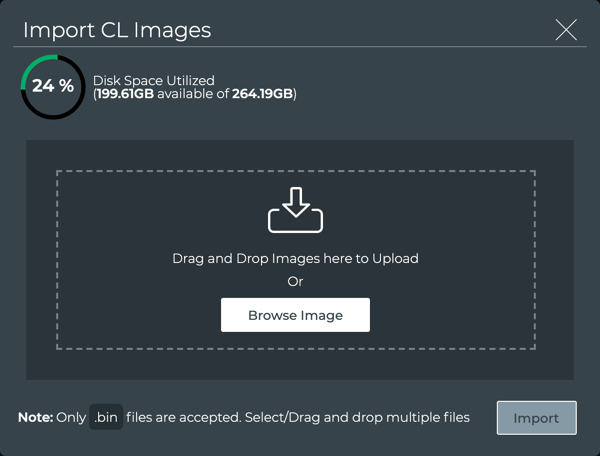
-
Provide the .bin file from an external drive that matches the criteria for the selected image(s), either by dragging and dropping onto the dialog or by selecting from a directory.
-
Click Import.


-
Click Done.
-
Click Uploaded to verify the image is in the repository.

-
Click
to return to the LCM dashboard.
The Cumulus Linux Images card now shows the number of images you uploaded.
-
Download the Cumulus Linux disk images (.bin files) needed for upgrade from the MyMellanox downloads page, selecting the appropriate version, CPU, and ASIC. Place them in an accessible part of your local network.
-
Upload the images to the LCM repository. This example uses a Cumulus Linux 4.1.0 disk image.
cumulus@switch:~$ netq lcm add cl-image /path/to/download/cumulus-linux-4.1.0-vx-amd64.bin -
Repeat Step 2 for each image you need to upload to the LCM repository.
For Cumulus NetQ images:
- On the NetQ Images card, click the View # missing NetQ images link to see what images you need. This opens the list of missing images.
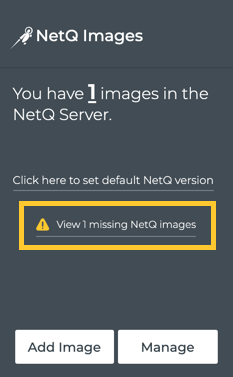
If you have already specified a default image, you must click Manage and then Missing to see the missing images.
- Select one or all of the missing images and make note of the OS version, CPU architecture, and image type. Remember that you need both image types for NetQ to perform the installation or upgrade.

-
Download the Cumulus NetQ debian packages needed for upgrade from the MyMellanox downloads page, selecting the appropriate version and hypervisor/platform. Place them in an accessible part of your local network.
-
Back in the UI, click
(Add Image) above the table.
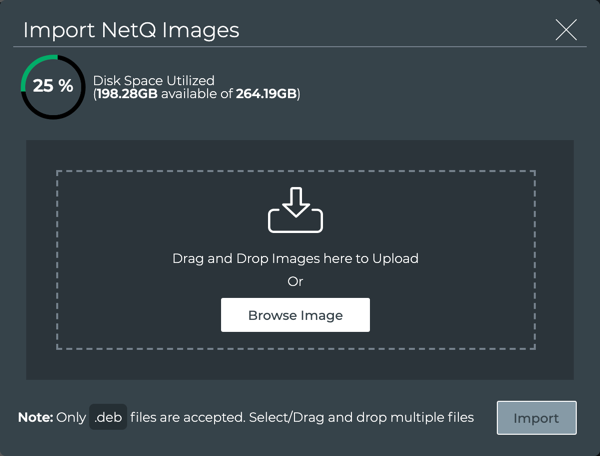
-
Provide the .deb file(s) from an external drive that matches the criteria for the selected image, either by dragging and dropping it onto the dialog or by selecting it from a directory.
-
Click Import.
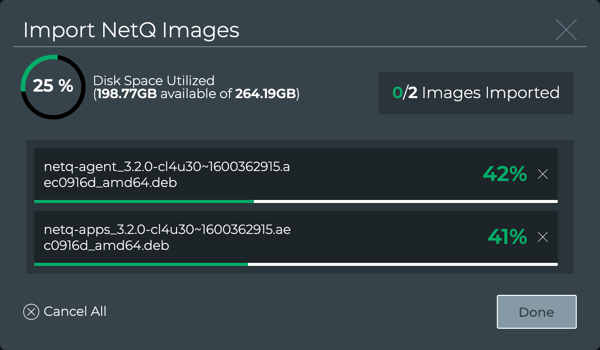
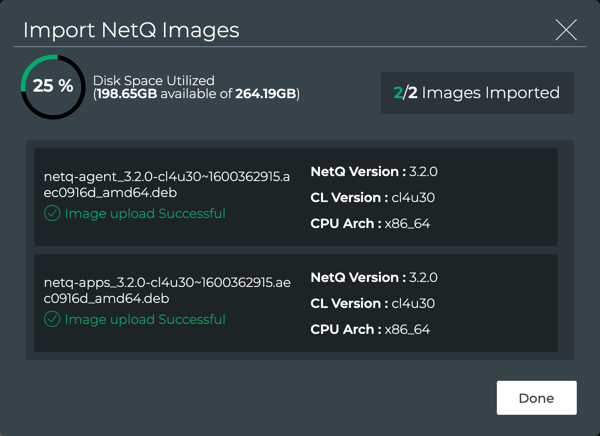
-
Click Done.
-
Click Uploaded to verify the images are in the repository.
When all of the missing images have been uploaded, the Missing list will be empty.
-
Click
to return to the LCM dashboard.
The NetQ Images card now shows the number of images you uploaded.
-
Download the Cumulus NetQ debian packages needed for upgrade from the MyMellanox downloads page, selecting the appropriate version and hypervisor/platform. Place them in an accessible part of your local network.
-
Upload the images to the LCM repository. This example uploads the two packages (
netq-agentandnetq-apps) needed for NetQ version 3.2.0 for a NetQ appliance or VM running Ubuntu 18.04 with an x86 architecture.cumulus@switch:~$ netq lcm add netq-image /path/to/download/netq-agent_3.2.1-ub18.04u31~1603789872.6f62fad_amd64 cumulus@switch:~$ netq lcm add netq-image /path/to/download/netq-apps_3.2.1-ub18.04u31~1603789872.6f62fad_amd64
Upload Upgrade Images
To upload the Cumulus Linux or Cumulus NetQ images that you want to use for upgrade:
First download the Cumulus Linux disk images (.bin files) and Cumulus NetQ debian packages needed for upgrade from the MyMellanox downloads. Place them in an accessible part of your local network.
If you are upgrading Cumulus Linux on switches with different ASIC vendors or CPU architectures, you will need more than one image. For NetQ, you need both the netq-apps and netq-agent packages for each variant.
Then continue with the instructions here based on whether you want to use the NetQ UI or CLI.
-
Click Add Image on the Cumulus Linux Images or NetQ Images card.
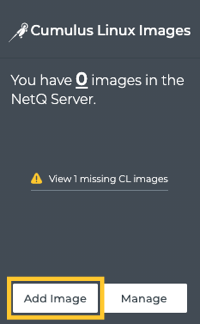
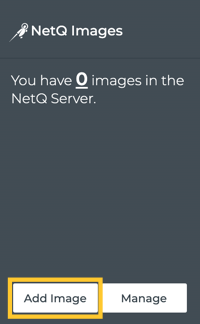
-
Provide one or more images from an external drive, either by dragging and dropping onto the dialog or by selecting from a directory.


-
Click Import.
-
Monitor the progress until it completes. Click Done.
-
Click
to return to the LCM dashboard.
The NetQ Images card is updated to show the number of additional images you uploaded.
Use the netq lcm add cl-image <text-image-path> and netq lcm add netq-image <text-image-path> commands to upload the images. Run the relevant command for each image that needs to be uploaded.
Cumulus Linux images:
cumulus@switch:~$ netq lcm add image /path/to/download/cumulus-linux-4.2.0-mlx-amd64.bin
Cumulus NetQ images:
cumulus@switch:~$ netq lcm add image /path/to/download/netq-agent_3.2.1-ub18.04u31~1603789872.6f62fad_amd64
cumulus@switch:~$ netq lcm add image /path/to/download/netq-apps_3.2.1-ub18.04u31~1603789872.6f62fad_amd64
Specify a Default Upgrade Version
Lifecycle management does not have a default Cumulus Linux or Cumulus NetQ upgrade version specified automatically. With the NetQ UI, you can specify the version that is appropriate for your network to ease the upgrade process.
To specify a default Cumulus Linux or Cumulus NetQ version in the NetQ UI:
-
Click the Click here to set the default CL version link in the middle of the Cumulus Linux Images card, or click the Click here to set the default NetQ version link in the middle of the NetQ Images card.


-
Select the version you want to use as the default for switch upgrades.
-
Click Save. The default version is now displayed on the relevant Images card.

After you have specified a default version, you have the option to change it.
To change the default Cumulus Linux or Cumulus NetQ version:
-
Click change next to the currently identified default image on the Cumulus Linux Images or NetQ Images card.
-
Select the image you want to use as the default version for upgrades.
-
Click Save.
Export Images
You can export a listing of the Cumulus Linux and NetQ images stored in the LCM repository for reference.
To export image listings:
-
Open the LCM dashboard.
-
Click Manage on the Cumulus Linux Images or NetQ Images card.
-
Optionally, use the filter option above the table on the Uploaded tab to narrow down a large listing of images.


-
Click
above the table.
-
Choose the export file type and click Export.
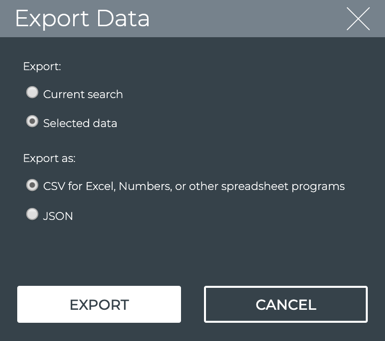
Use the json option with the netq lcm show images command to output a list of the Cumulus Linux image files stored in the LCM repository.
cumulus@switch:~$ netq lcm show images json
[
{
"id": "image_cc97be3955042ca41857c4d0fe95296bcea3e372b437a535a4ad23ca300d52c3",
"name": "cumulus-linux-4.2.0-vx-amd64-1594775435.dirtyzc24426ca.bin",
"clVersion": "4.2.0",
"cpu": "x86_64",
"asic": "VX",
"lastChanged": 1600726385400.0
},
{
"id": "image_c6e812f0081fb03b9b8625a3c0af14eb82c35d79997db4627c54c76c973ce1ce",
"name": "cumulus-linux-4.1.0-vx-amd64.bin",
"clVersion": "4.1.0",
"cpu": "x86_64",
"asic": "VX",
"lastChanged": 1600717860685.0
}
]
Remove Images from Local Repository
Once you have upgraded all of your switches beyond a particular release of Cumulus Linux or NetQ, you may want to remove those images from the LCM repository to save space on the server.
To remove images:
-
Open the LCM dashboard.
-
Click Manage on the Cumulus Linux Images or NetQ Images card.
-
On Uploaded, select the images you want to remove. Use the filter option above the table to narrow down a large listing of images.


- Click
.
To remove Cumulus Linux images, run:
netq lcm show images [json]
netq lcm del image <text-image-id>
-
Determine the ID of the image you want to remove.
cumulus@switch:~$ netq lcm show images [ { "id": "image_cc97be3955042ca41857c4d0fe95296bcea3e372b437a535a4ad23ca300d52c3", "name": "cumulus-linux-4.2.0-vx-amd64-1594775435.dirtyzc24426ca.bin", "clVersion": "4.2.0", "cpu": "x86_64", "asic": "VX", "lastChanged": 1600726385400.0 }, { "id": "image_c6e812f0081fb03b9b8625a3c0af14eb82c35d79997db4627c54c76c973ce1ce", "name": "cumulus-linux-4.1.0-vx-amd64.bin", "clVersion": "4.1.0", "cpu": "x86_64", "asic": "VX", "lastChanged": 1600717860685.0 } ] -
Remove the image you no longer need.
cumulus@switch:~$ netq lcm del image image_c6e812f0081fb03b9b8625a3c0af14eb82c35d79997db4627c54c76c973ce1ce -
Verify it has been removed.
cumulus@switch:~$ netq lcm show images [ { "id": "image_cc97be3955042ca41857c4d0fe95296bcea3e372b437a535a4ad23ca300d52c3", "name": "cumulus-linux-4.2.0-vx-amd64-1594775435.dirtyzc24426ca.bin", "clVersion": "4.2.0", "cpu": "x86_64", "asic": "VX", "lastChanged": 1600726385400.0 } ]